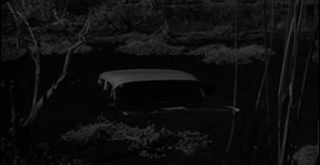Film Language and Representation
(Only second half of my extract)
The extract I have chosen was the cleanup and hiding of Marion Crane's body and car, which took place after the notorious shower murder (starts at 55:00). The character being focused on in this scene is Norman Bates, as he disposes of Marion's body by storing it in her trunk along with her other belongings. Bates then drives the car to a nearby swamp and sinks it, thus hiding all evidence. This event finalized the end of Marion Crane and how the plot shifts full focus on Norman Bates.
 Anthony Perkins' acting really sells the character of Norman Bates here. At this point in the film (having no prior knowledge) one would believe that Norman's mother is the murderer, and within the first two minutes he plays the role of innocent son defending his mother. The action in which he wraps the shower curtain is executed so cleanly, carefully, and professionally. Even around a minute in, he cautiously checks around as cars pass by, really portraying that innocent and shocked character. No one would have guessed that he's the psychotic antagonist behind this film all along. However, when he reaches the swamp, his character begins to gain that sinister tone behind him. The way he menacingly watches over the sinking car brings forward only dark undertones.
Anthony Perkins' acting really sells the character of Norman Bates here. At this point in the film (having no prior knowledge) one would believe that Norman's mother is the murderer, and within the first two minutes he plays the role of innocent son defending his mother. The action in which he wraps the shower curtain is executed so cleanly, carefully, and professionally. Even around a minute in, he cautiously checks around as cars pass by, really portraying that innocent and shocked character. No one would have guessed that he's the psychotic antagonist behind this film all along. However, when he reaches the swamp, his character begins to gain that sinister tone behind him. The way he menacingly watches over the sinking car brings forward only dark undertones.
The cinematography of this scene really conveys the shift from innocence to morbidity within the plot of Psycho. With the body-wrapping scene, Hitchcock hides the body itself from our view as it's being wrapped in the shower curtain. If we were to have seen the body, the film would be too gruesome and would be a bit too gruesome too early. However as we reach the swamp again, right after the car is shown sinking, it cuts to a close-up of Norman Bates' sinister face looking down upon the lost evidence. The low angle close-up gives the audience a sense of power within Norman Bates, as he makes the car (and Marion) seem inferior to him.
The editing supports each theme being represented, as pacing and shot selection can be potential factors altering how these themes are conveyed. For example, we see that Tomasini (editor) liked to switch between the shot of Norman's face looking down on the swamp and the car sinking. This constant switch made the scene a little uneasy, as it kept cutting to a previous shot, and as viewers, have to watch the car completely sink (which i'm sure stops at one point then continues).
The lighting within this extract was very powerful in its use of cast shadows seen on Norman's face as he looks upon the car. These shadows drag across half of his face, which conveys a dark, mysterious look. The mystery behind his character pretty much sets up the anticipation for the rest of the film, as we lean toward Bates being the murderer, rather than his mother.
 an unsettling scene, in which the audience tends to only imagine the horror of the corpse that lays in the curtain. The sharp violins re-accompany the bass as Bates loads up the trunk with Marion's belongings. These noises are only a bit soft at this point, however completely goes silent as he's sinking the car. This also unsettles the audience and causes more attention to the expressions of Bates as the car goes down.
an unsettling scene, in which the audience tends to only imagine the horror of the corpse that lays in the curtain. The sharp violins re-accompany the bass as Bates loads up the trunk with Marion's belongings. These noises are only a bit soft at this point, however completely goes silent as he's sinking the car. This also unsettles the audience and causes more attention to the expressions of Bates as the car goes down.One setting of this extract that is worth mentioning is that of the swamp. When the car begins to sink, the setup of this shot has elements in the foreground, middleground, and background. The openness of the elements in the shot guide our eyes toward the middle, where the car is placed.
The emotional information conveyed gives the audience a sort of glimpse into the mind of Norman Bates. Knowing of Marion Crane's past, and contrasting it with the initial innocence we see with Norman, there is almost a form of sympathy for Norman. I know personally that I didn't feel any remorse for Marion as that car slowly sank to the bottom of the swamp. The mood of this scene is very pivotal to the plot, as Hitchcock slowly transitions the plot focus onto Norman through this scene.


No comments:
Post a Comment